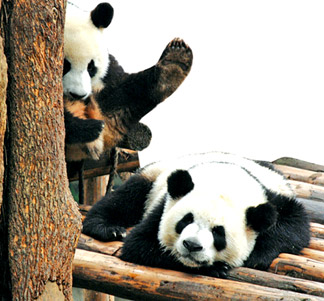|
Memorable visit to Chengdu Panda Base:
Brighter future for 'living fossil'
By Indunil THENUWARA
 We
waited with bated breath. In the hushed silence, one could almost hear a
pin drop. Soon we could witness the rustling of leaves, and anticipation
reached fever pitch. About 15 seconds later a ball of black and white
rolled into view. We
waited with bated breath. In the hushed silence, one could almost hear a
pin drop. Soon we could witness the rustling of leaves, and anticipation
reached fever pitch. About 15 seconds later a ball of black and white
rolled into view.
Yes, we were staring at a panda, large as life, and yes, it was just
as cute and cuddly as the soft toys that we are more familiar with.
The first panda was soon joined by another one. While the first one
remained in the background, minding its own business - climbing trees
and brushing against tree trunks - the second one seemed to be more
adventurous; it walked right towards us and struck a pose. The cameras
started clicking non-stop. Despite notices ‘Silence please’ and ‘Shhh
I’m sleeping now’, we were so overwhelmed by the sight of these lovable
giants that we couldn’t help letting out whoops of delight.
We were a group of 11 journalists from Asian and African countries
accompanied by personnel from China’s Xinhua News Agency and we were at
the Chengdu Research Base of Giant Panda Breeding in China’s Sichuan
Province.
We were witnessing a ‘living fossil’ in action. Accoring to our
English-speaking guide who took us around the panda breeding centre,
pandas have a history dating back eight million years.
The endangered animals are naturally found only in the bamboo groves
of 40 counties in China’s Sichuan, Gansu and Shaanxi provinces and the
eastern part of the Tibetan plateau, and live in climes about 1,500
metres above sea level. The Baoxing County is considered the home of the
panda and it was in Dengchigou of this county in 1869 that a panda was
discovered for the first time by French missionary and natural
historian, Jean Pierre Armand David.
Patches of black
The bear with large distinctive patches of black around its eyes,
over the ears and across its round body is considered a national
treasure in China and the massive investments made by the government
towards its protection has proved to be successful. Since 1963, China
has established 62 panda natural reserves where over 1,590 of these
creatures live. There are believed to be between 2,000 and 3,000 pandas
in the wild although exact figures are not known. By 2006, China had 30
artificially bred pandas; now the figure stands at over 220.
 |
|
The entrance to the
centre |
Since these beautiful animals prefer a solitary life, most of them
are ‘caged’ separately as otherwise they start fighting with each other.
However, their ‘cages’ are spacious enclosures providing elements of
their natural habitat, with enough trees, bushes, logs and water bodies
for them to play and frolic in. The natural environment and man-made
landscape have been creatively combined to provide an ideal living area
for the pandas.
These lovely creatures prefer a cold climate and we were told that
the temperature when we visited, 15-20 degrees Celsius, was ideal for
them. They are provided with air-conditioning facilities during summer,
our guide said. An adult panda weighs about 125-150 kilos and is about
1.5 metres long. They have a lifespan of about 20 years in the wild and
30 years in captivity.
The pandas, despite most of them remaining in various states of
sleep, still kept us enthralled and entertained. As our guide explained,
this gentle giant’s diet consists mainly of bamboo shoots (of which it
eats about 9-14 kilos per day) and lacks the essential protein element.
Therefore, it sleeps for most part of the day to conserve its energy.
Apparently, a panda eats for two hours and sleeps for 10 hours.
Also, the panda is very particular about its diet. It consumes only
about 16 varieties of bamboo and leaves other bamboo species alone. At
the breeding centre they are provided with food items such as apples and
other fruits and yams which they also seem to relish.
According to our guide, pandas are believed to have been carnivorous
many years ago, but when much of its prey went extinct due to reasons
such as hunting, clearing of habitat and climate change, the panda
gradually turned herbivore. However, it still has the digestive tract of
a carnivore and that’s why it’s diet is not sufficient for the animal.
Research and breeding
 |
|
The entrance to the
centre |
 |
|
A red panda
Pix: Indunil Thenuwara and Xinhua, Beijing |
The Chengdu Panda Base, set up in 1987, is a non-profit research and
breeding facility for giant pandas and other endangered animals. The
base which started with six pandas rescued from the wild now has about
60 of them. The rest born and bred there have been sent to zoos in
different parts of China as well as to other countries as gifts of
friendship. Our guide explained that there are altogether about 2,000
pandas in the Sichuan Province.
The main goals of the Chengdu Base are wildlife research, captive
breeding, conservation education and educational tourism. It’s spread
over 106 hectares, is equipped with all modern scientifc facilities and
conducts research into pandas’ reproduction, nutrition, behaviour and
veterinary medicine so that better care and management of the animals is
possible. It works with several international organisations towards
panda conservation and has won many awards including the Global 500
award presented by the United Nations Environment Programme.
This year had seen the birth of 10 pandas at the Chengdu centre. A
high point of our tour was the visit to the panda nursery where four
three-month old cubs and one two-month old were being attended to by the
trained handlers.
Despite being the king, the giant panda was not alone at the Chengdu
Panda Base. It was also home to the red panda. This animal is not a real
bear, is slightly bigger than a domestic cat and is closer to the
raccoon, skunk and weasel family. It has reddish brown fur, a long and
shaggy tail and front legs which are shorter than the hindlegs. Peacocks
were also in abundance at the centre.
It is on a rare occasion that one comes across a living fossil. It is
a double bonus if that fossil happens to be as cute as this. Also, the
panda is a unique and endearing symbol of China. Of the many places that
we visited during our tour to this amazing land, which was organised by
Xinhua under the aegis of the World Media Summit, the visit to the panda
breeding centre would remain as one of the most memorable.
|

